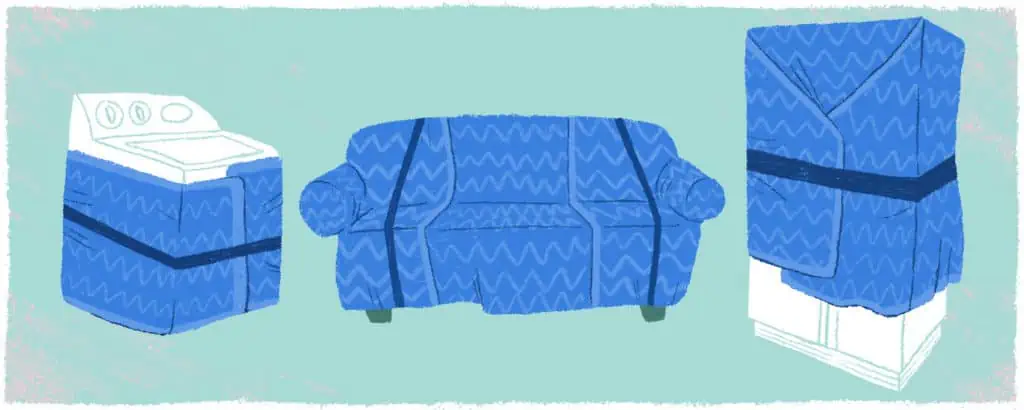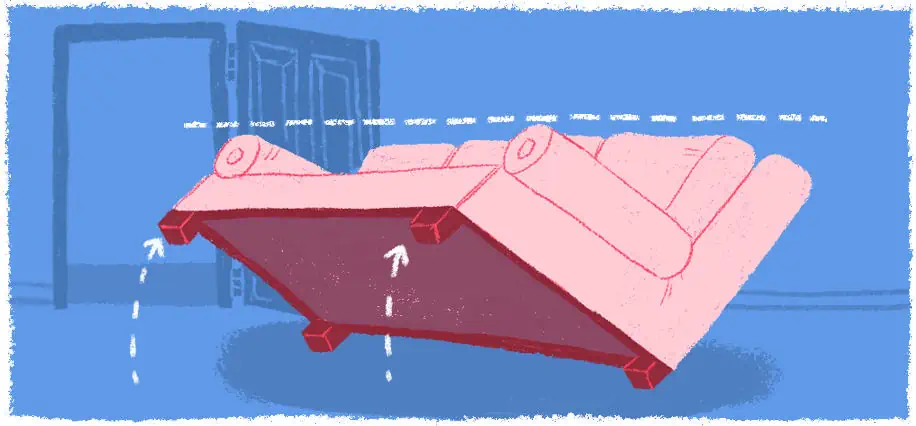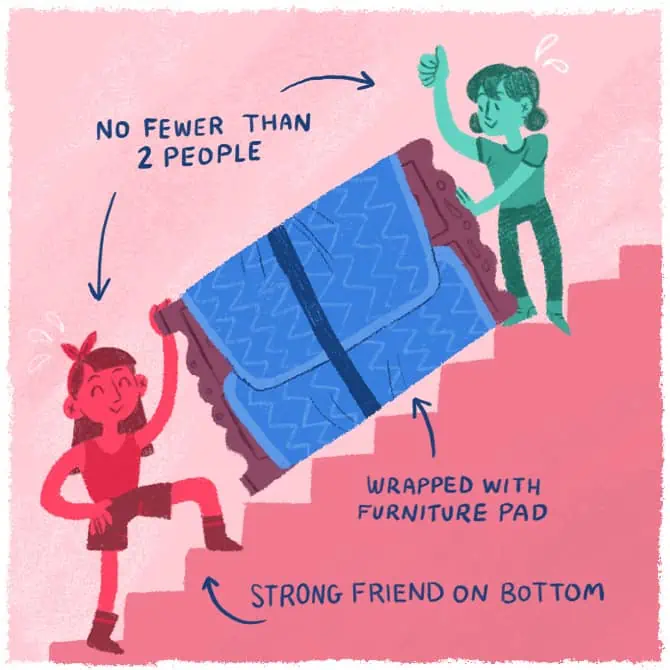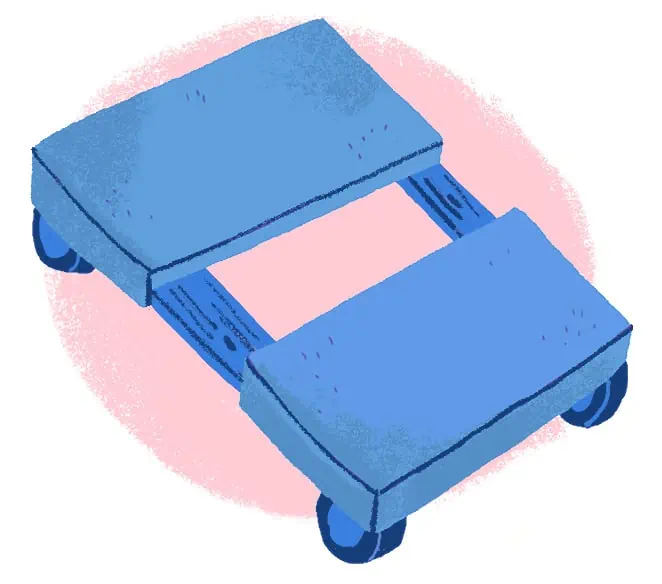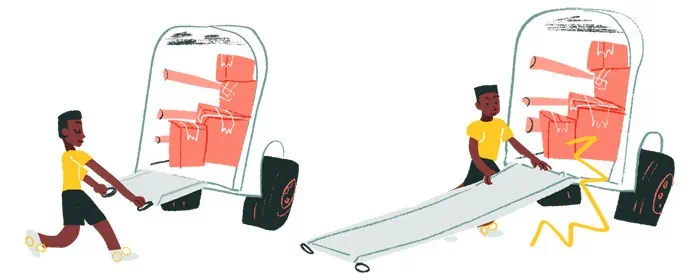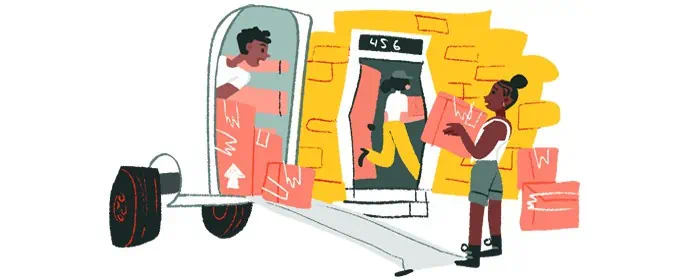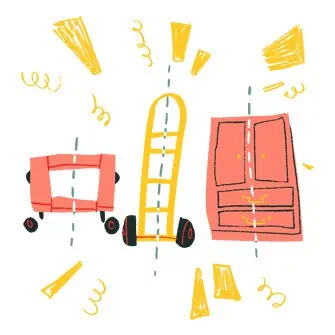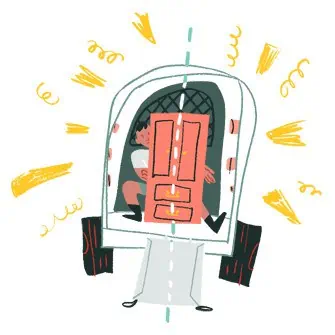Chances are, there are near by movers who can help you move that fridge, bed, or whatever else makes your back ache by the mere thought of picking it up. But if you can’t find the right help, or if you and your back feel up to the task, then keep reading—we’ve got you covered!
The First Step to Moving Heavy Furniture
Abraham Lincoln once said, “Give me six hours to chop down a tree and I will spend the first four sharpening the axe.” Okay, that’s a little weird, but moving heavy furniture is the same idea. You gotta really, really prepare.
Before you roll up your sleeves and start picking stuff up, you’ll want to do a few things:
- Clear as wide of a pathway as you can
- Measure that your furniture isn’t too big to go through that path
- Mark a clear, physical end point where you will drop the item
The last one will probably be near your moving truck or storage container or, if you’re particularly strategic, a staging area (meaning your driveway, sidewalk, or the garage during sketchy weather) in order to better “Tetris” your stuff.
Disassembling Furniture
The great news is that many movers across the country will offer to disassemble any furniture that might need it in order to be moved. All you have to do is ask if your local mover offers the service.
If you’re disassembling furniture all yourself, there are plenty of basics to know when taking off table legs, moving desks, or detaching a flat screen tv.
The Most Important Basics When it Comes to Disassembly
- When removing table legs, immediately reattach whatever nuts and bolts were holding the leg in place after the leg is off. This keeps screws from disappearing
- Always use a screwdriver with a magnetic head when unscrewing flat-screen tv mounts, as losing important screws is extremely easy to do
- Dresser mirrors always get removed and properly packed up. Any undetachable dresser mirrors require tons of special attention to move
- Dining room chairs aren’t often designed to be taken apart easily, if at all. But if you have chairs with exposed bolts or screws, you may be able to disassemble them
The above just scratches the surface of what professional movers with experience know about moving furniture and disassembling furniture. You’ll learn plenty, just like I did, by trying to do it yourself.
Get Help Unloading Your Rental Truck
See prices for movers by the hour—instantly.
Read real customer reviews.
Easily book your help online.
“The IKEA-Exception”
The furniture in your home didn’t just grow there, right? It had to have been carried in.
But the one exception to the “furniture doesn’t grow there” concept is IKEA-like furniture, or in other words, most anything you had to assemble yourself.
Full-Service moving companies will generally refuse to move customer-assembled furniture made of pressboard. This is because such furniture was designed to be assembled, put in place, and never ever moved again. Any customer requesting their pressboard bookcase (or pressboard anything) be professionally moved usually has to sign a waiver stating they understand it will very likely get destroyed and the movers will assume zero responsibility for the destruction.
If you have any pressboard furniture or any furniture that – be honest with yourself – is generally cheap and flimsy, consider selling it or giving it away. Moving it costs time and money and will more than likely turn it into an unusable piece (or pieces) of trash.
Wrapping Furniture
At some point during the move-out process, you’ll need to wrap your furniture so it doesn’t get scratched, gouged and cracked into oblivion.
Cloth furniture pads (also known as “moving blankets”) are what movers use, and we highly recommend them. Wrapping your furniture before you carry it through your home and out the door can help protect it against incidental dings in the doorway and, quite possibly, holes in your walls.
No true professional mover will ever dream of transporting heavy furniture without furniture pads.
Protip: Moving pads can make it hard to keep a firm grip on your furniture. I always preferred to wrap everything in the staging area, or right there on the truck.
The Most Important Basics When it Comes to Wrapping Furniture
Wrapping a refrigerator or a bookcase is pretty straightforward. Wrapping a non-rectangular item like a sofa or a chair can be a challenge.
- The key is to secure your furniture pads neatly and tightly, covering every surface except, in general, the bottom side
- You mostly need to just make sure the pads don’t come off. Some movers use shipping tape to keep their pads in place, while others use shrink wrap. Both are effective but costly (not to mention a little wasteful). That’s why other movers use big rubber bands called “mover’s bands”. They are versatile and reusable for applications far beyond moving furniture (like, say, wrapping an office chair)
- To secure those pads, whether you use tape, shrink wrap or those big rubber bands, just remember: avoid putting tape or shrink wrap directly on your furniture’s surfaces
How Many Furniture Pads Do I Need?
For reference, furniture pads the pros use measure 72” x 80”, give or take.
End tables, small bookcases, and dining room chairs usually only need one (1) pad; most furniture needs two (2), while things like sofas, really large dressers, even some big headboards need three (3) apiece.
How many furniture pads do you need, then? Your best bet is to go from room to room, check how many things you have that need to be wrapped, note how many pads each item will require to cover their surface, then tally it all up. (To be safe, you might want to tack on a half dozen more!)
How Do Pros Move Furniture Through Doorways?
Angling
If your sofa is too wide to fit through a doorway in your home, there are a few things you can do.
The simplest is to tilt it 45 degrees (more or less) so the front edge of the seat cushions and the top of the back of the couch are aligned vertically. This will make the bottom rear edge of the couch look like it is sticking further out, but all you geometry lovers out there will appreciate how this actually makes the couch narrower.
Curling
If your couch is still too wide, try standing it on end and curling it through.
Laying down a blanket first will help you smoothly and safely slide your couch through the doorway. Ease the top back edge through first, then curl the sofa around the side of the doorway closer to the seat cushions as you slip the rest of the couch through. (You can also push it through seat cushion edge first.) This same strategy can be used when trying to get oversized easy chairs through a seemingly too-narrow door.
Detaching
If you find you need a few extra inches of clearance before your sofa will pop through that doorway, try removing the legs or feet.
Even though they are sometimes nothing but short squares of wood, I’ve found on many occasions that taking them off is the difference between success and a damaged door jamb. On occasion, I’ve had to actually remove a door from its hinges in order to get a couch out the door. While not difficult, you will need a flat head screwdriver and a hammer to coax those hinge pins out, and a couple of extra sets of hands to keep the door in place until those pins pop free.
Moving Furniture Up and Down Stairs
Hauling large pieces of furniture – more importantly, heavy pieces of furniture – down a flight of stairs is a dangerous proposition if you don’t take it slow (and smart).
- Make sure you have a strong friend (if not two) on the lower end as you go down (or up) the stairs. Take those steps one at a time. Rest as often as need be, simply by laying that dresser or bookcase down, right on the stairs. Just make sure it doesn’t start sliding!
- Watch for walls, banisters, and hanging light fixtures
- It’s easy when you’re watching your feet to forget about everything else. And that, I can tell you, includes your knuckles!
- When sliding items around corners on landings, use a blanket underneath
- When doing so, put a blanket down to make the sliding process easier and to avoid damaging that dresser and/or the floor. If the floor is carpeted, the item is really heavy, or if the surface it is resting on is uneven, try walking that thing forward – using small, slow, easy steps
Using Wheels to Move Your Furniture
If you aren’t The Hulk, a little extra help in the form of wheels can make a huge difference. Here are what the pros use:
- 4-wheeler: A 4-wheeler is great for moving large, heavy items over long flat distances. Two main things to watch for: your piece of furniture is resting firm and balanced, and that the wheels, usually black rubber, aren’t marking or scuffing your floors.
- Hand truck: A hand truck has two wheels and a metal plate on which to rest your furniture, and a long upright surface with handles. Their soft-ish wheels let you move heavy items up and down stairs and across uneven surfaces all by yourself. However, we highly recommend having a second set of hands at the lower (bottom) end of that piece of furniture any time you are negotiating stairs.
- Appliance dolly: An appliance dolly is basically a heavy-duty hand truck with a strap to secure in place the refrigerator, washing machine, dryer or whatever. Despite its name, an appliance dolly can absolutely be used to haul furniture.
This All Seems Hard. Are There Furniture Movers Near Me, Just In Case?
Most likely, yes!
See prices for local moving labor. Read real customer reviews. Easily book your help online.
Start by searching HireAHelper’s massive network of local movers to find movers near you to tackle the big stuff. You don’t necessarily need to hire an entire moving crew if you just need to move your heaviest items.
Normal moving rates will apply, usually starting at a couple hundred bucks for two experienced professionals for two hours. They will usually bring all the necessary equipment, too!
If you just aren’t sure you want to move heavy furniture yourself, relax. Professionals know how to do everything in this article. If you’re doing a long distance move, our sister company Moving Place can provide you with movers, transportation and everything you might expect from a full service move at a fraction of the price.


